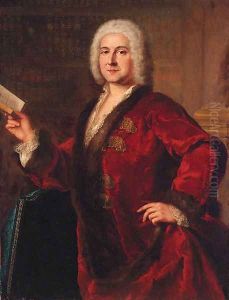Franois De Troy Paintings
François de Troy was a French painter and engraver born on January 9, 1645, in Toulouse, France. He came from a family of artists, as the son of the portrait painter Jean de Troy. François was trained by his father before moving to Paris to further his education. His early career in the capital was marked by his work in the studio of Nicolas-Pierre Loir, where he honed his skills in portraiture and history painting.
De Troy's work was influenced by the classical style of the French Royal Academy, which was characterized by its adherence to the principles of order, harmony, and balance. He became a member of the Royal Academy of Painting and Sculpture in 1674 and was received as a history painter with his presentation of a work entitled 'Time Unveiling Truth.' His talent for portraiture, however, soon overshadowed his historical compositions, and he became renowned for his ability to capture the likeness and character of his sitters.
In 1698, de Troy was appointed as the director of the French Academy in Rome, a prestigious position that affirmed his status as a leading artist of his time. During his tenure in Rome, he influenced many young artists and was responsible for sending artworks back to France to inspire his contemporaries. His stay in Italy lasted until 1708, after which he returned to Paris.
Upon his return, François de Troy continued to receive commissions from the French aristocracy and the royal family. His portraits were celebrated for their elegance and refinement, often depicting the sitters in lavish clothing and within opulent settings. De Troy's style represented the transition from the grand, rhetorical art of Louis XIV's reign to the more intimate and decorative tastes of the Regency period.
François de Troy died on November 21, 1730, in Paris. His legacy endured through his influence on younger artists and his son, Jean-François de Troy (1679-1752), who was also a respected painter. The works of François de Troy can be found in various museums and collections around the world, showcasing his contributions to the French classical tradition in painting.
